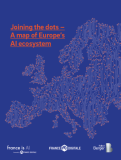

Connecting the dots – A map of Europe’s AI ecosystem
European AI, where are you? What do you look like? Who is mastering you? As we all know, the battle for AI supremacy has begun. And it is now time for Europe to better know its strengths, and capitalize on it.
Roland Berger and France Digitale have joined forces to prepare the first mapping of European Artificial intelligence ecosystems. Both share a conviction: AI will be an opportunity for the coming European generations, provided it is properly implemented and integrated in European global strategies.

This study is the first edition of what will be a long-term knowledge tool on European AI ecosystems, providing a great base to bolster Europe’s fight for AI leadership.
I have been delighted to present the conclusion of this study together with Damien Gromierduring the second day of our FranceisAI 2018 conference.
To win the race, we need to better understand who exactly is developing European AI, where they’re based and what they’re doing. If startups are a vital part of AI development, this also includes research laboratories and all manner of communities, from informal groups to conferences and associations, which put AI on the European agenda*. We have looked at how these players are distributed among European countries, both in terms of volume and density.
Using this approach, we identified three European country profiles. Where France, United Kingdom and Germany are the leaders and contribute 60% of the artificial intelligence ecosystem in volume, other countries are taking flight. We called them the rising stars. They are mainly Nordic and Baltic states that are becoming increasingly influential in AI, thanks to their very dense ecosystems. The remaining countries are positioned as followers.
What can explain the leaders' success? They have seized the potential of key sectors of artificial intelligence as tech, financial services, entertainment, media, culture, healthcare and biotech. In other words, they have developed and impose an AI industrial model that is then replicated by the others.
Europe has a strong AI ecosystem, full of resources, but the landscape is much too fragmented. For now, it is not in a position to compete with the US or China. The European Strategy for Artificial Intelligence was launched in April 2018, backed by €1.5 billion in funding. But the EU budget for promoting and fostering AI development is relatively low compared to the US and China, whose governments have announced 10 figure budgets to win the AI race.
To move away from the current ecosystem of isolated national AI models dominated by a handful of leading players towards a more holistic, European ecosystem with a unified voice, change is required. Roland Berger and France Digitale have identified fivelevers to operate:
- A proactive open data policy, permitting access to the vast quantity of data the public sector sits on. Achieving this requires the removal of burdensome regulation, such as the text and data mining restrictions in the Copyright Directive review. The Free Flow of Data regulation is a model to be followed in this regard.
- A common and clear legal framework for scientists
- Pooling of investments to reach the critical mass
- Better clusterisation of our investments to create a real pool of expertise and reinforce our uniqueness and European identity
- Better retention of our technical and scientist talents
This mapping of AI European ecosystem will be updated on a regular basis, to consolidate Europe's strengths on the path to success!
* Methodology for European AI ecosystem :
- Startups : both Producers and users of artificial intelligence
- Labs (Education labs, Public institutions, Corporate labs, Private-Public partnerships)
- Communities (Groups, Events, Associations, Other networks

